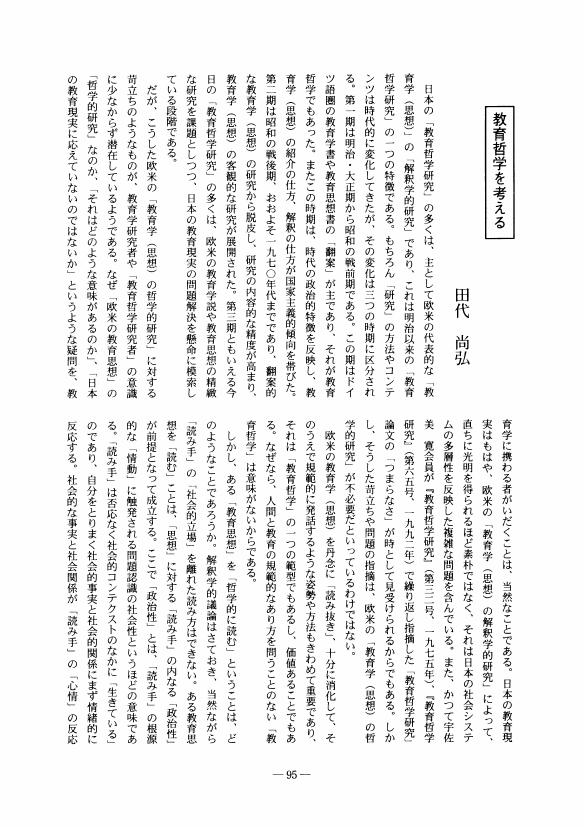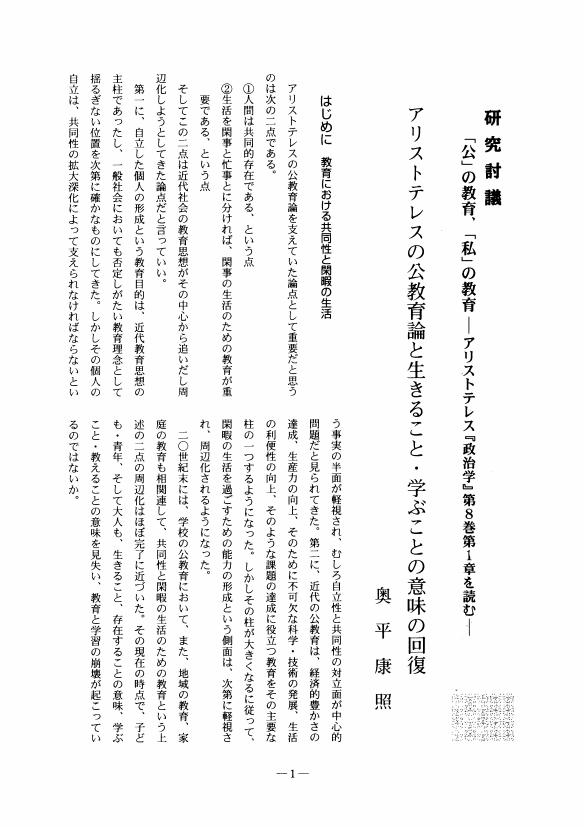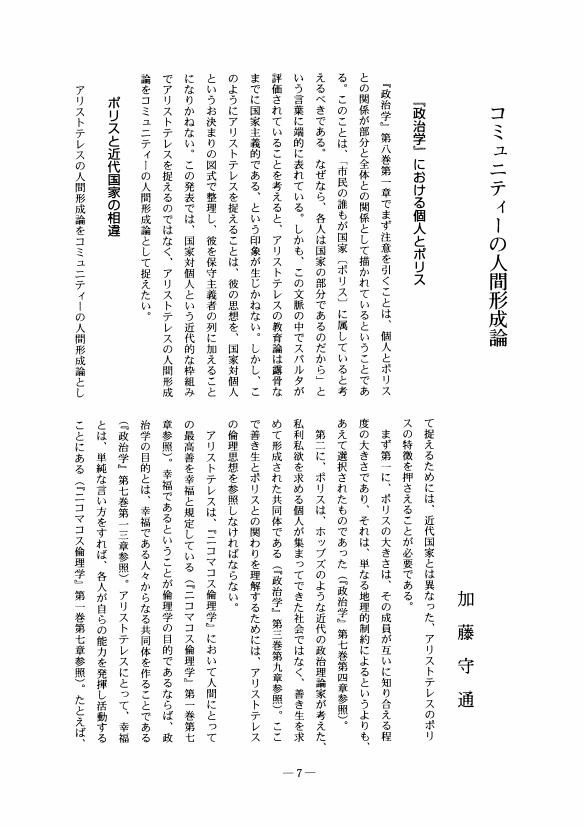1 0 0 0 OA ペスタロッチーの『探究』における教育の二つの次元 『探究』の新たな批判をふまえて
- 著者
- 小野寺 律夫
- 出版者
- 教育哲学会
- 雑誌
- 教育哲学研究 (ISSN:03873153)
- 巻号頁・発行日
- vol.2003, no.88, pp.18-35, 2003-11-10 (Released:2009-09-04)
- 参考文献数
- 25
Man hat immer wieder behauptet, daß Pestaozzi der Begründer der modernen Pädagogik sei. Der Text der “Nachforschungen” ist für eine solche These von entscheidender Bedeutung, denn man stellt fest, daß von der anthropologischen Konzeption dieses Textes her der Versuch der “Methode” als Hilfe zur Selbsttätigkeit ausgehe. Das ist der Grund warum die“Nachforschungen” nicht nur die Stellung eines Hauptstücks der modernen Pädagogik innehaben, sondern in den letzen Jahren auch zum Angriffziel der soziologischen Forschungstendenz einer Entmythologisierung Pestalozzis durch Oelkers und Rang werden. Zweck dieser Abhandlung ist es, eine textimmanente Interpretation und die Umrisse eines inneren Zusammenhangs der Absicht der “Nachforschungen” zu versuchen und damit die Bedeutung dieses Textes für die Untersuchung zweier gegenseitig nicht reduzierbarer Dimensionen der Erziehung, der soziologische und der anthropologische, zu erklären.Die soziologische Dimension stellt Sozialization dar. Nach Pestalozzi ist sie zwar der eigentümliche Prozess und die notwendige Wirkung der menschlichen Gesellschaft, aber sie ist die auf den Perspektivismus gegründete Auffassung von der Erziehung als “Verstümmelung” und damit im inneren psychologischen Prozesse des gesellschaftlichen Menschen ein Unterliegen des Ichs gegen den Instinkt, nämlich “die Widersprüche in der menschlichen Natur” hervorrufend. Dagegen stellt die anthropologische Dimension die gesellschaftliche Veredlung dar. Sie ist die sich über den Perspektivismus erhebende Wirkung, welche die Bildung und Entwicklung der teilnehmende Gemütsstimmung fordern kann, sie kann den Weg zur Auflosung der “Widersprüche” vorbereiten. Wir haben zuerst mit der Identifizierung des Themas des Textes “Nachforschungen” begonnen und dann im Zusammenhang mit dem Thema eine innere Zusammenhang dieser zwei Dimensionen erläutert. Und somit haben wir auch erwähnt, daß die Forschungen der Entmythologisierung eine unzutreffende und überzogene Interpretation darstellen.
1 0 0 0 OA ペスタロッチの文体について その意味と必然性
- 著者
- 高橋 春幸
- 出版者
- 教育哲学会
- 雑誌
- 教育哲学研究 (ISSN:03873153)
- 巻号頁・発行日
- vol.2003, no.88, pp.36-50, 2003-11-10 (Released:2010-01-22)
- 参考文献数
- 23
Pestalozzis Stil hat einen wesentlichen Bezug zu seine Gedankenbildung. Pestalozzi war ein Pädagoge, der sein Denken und Wollen durch des Stil ausdrücken wollte und verschiedene Schreibarten in seinen Werken erprobt hat. Der fundermentale Stil Pestalozzis war “Rede”, in der auf Ton und Bild großen Wert gelegt wurde.Diese Abhandlung versucht, Pestalozzis Stil, - “die Rede” und den Sinn in seinem frühen repräsentativen Werk, “Die Abendstunde eines Einsiedlers” zu beleuchten. Dazu wird die Arbeit von Rupprecht genützt, der in seinem Werk Reim und Rhythmus der Abendstunde dargestellt.In dieser Abhandlung werden drei Themen erortert.1. Der typische Stil in “Abendstunde” “Die Abendstunde” ist nicht Aphorismus sondern eine Rede, die an die Menschheit ruft, worm eine geradezu pedagogische und propagatorische Absicht liegt. Hier wird die Rede aus dem Aspekt des Rufs erläutert.2. Der Rhythmus und das Bild des Kreises im Stil der “Abendstunde” Das wichtigste Bild, - das der Kreise - wird hier, anhand der Auffassung Rupprechts, erklärt. Das Bild soll nicht nur in Worte sondern auch in Ton gefassed werden.3. Stil und GlaubePestalozzis Stil, - “die Rede” - spiegelt seinen Glauben wieder. Sein Stil kann nicht nur als Schreibweise sondern als seine Lebensweise angesehen werden, die auf dem christlichen Glaube beruht.
1 0 0 0 OA 教育的関係におけるコミュニケーション的行為の可能性 相互承認による自己形成論へ
- 著者
- 藤井 佳世
- 出版者
- 教育哲学会
- 雑誌
- 教育哲学研究 (ISSN:03873153)
- 巻号頁・発行日
- vol.2003, no.88, pp.67-83, 2003-11-10 (Released:2010-05-07)
- 参考文献数
- 53
The present paper clarifies possibilities of communicative actions for education by considering the teacher-student relationships as intersection of a social dimension (institutional dimension) and an ontological dimension (a recognition dimension). Based on Habermas's communicative actions theory, Masschelein argues that proper educational actions are communicative actions because students will form themselves through “inter-subjectivity (Intersubjektivität)” of teacher-student relationship. In his theory, teachers and students are regarded as a symmetrical interaction. But, to realize educational actions as communicative actions, it is not enough to consider the teacher-student relationship as a symmetrical interaction. Teachers and students need the ontological recognition of each other. This is an important point of Honneth's mutual recognition theory which is derived from Habermas's “understanding (Verständigung)” concept. As Honneth suggests, self-confidence, self-respect, and self-esteem that we need to grow are produced by symmetrically inter-active relationships based on reciprocally ontological recognition. From the perspective of ontology, the inter-subjectivity of the teacher-student relationship is realized on the basis of reciprocally ontological recognition. One student's ontological recognition of himself/herself needs one teacher's ontological recognition of that student. If we want to understand educational actions as communicative actions, we must understand the importance of the reciprocally ontological recognition of both teachers as well as students.
- 著者
- 藤田 雄飛
- 出版者
- 教育哲学会
- 雑誌
- 教育哲学研究 (ISSN:03873153)
- 巻号頁・発行日
- vol.2003, no.88, pp.84-100, 2003-11-10 (Released:2010-05-07)
- 参考文献数
- 36
Cet article envisage la notion de « polymorphisme » à partir de la transcription du cours donné par Maurice Merleau-Ponty à la Sorbonne. Nous pouvons dire que ce cours, dans sa totalité, se présente comme une analyse des mécanismes de socialisation. Le polymorphisme qui caractérise l'état des enfants à leur naissance, est l'expression de la richesse de leurs possibilités avant qu'ils ne soient pleinement immergés dans la culture et contraints par elle. De ce point de vue, la socialisation est moins un processus d'acquisition des normes et des codes culturels que l'appauvrissement et la perte progressive du polymorphisme premier. Cette approche du développement est susceptible de faire exploser le schéma qui pose, face à un adulte pleinement réalisé, une image déficitaire de l'enfant, envisagé comme un être encore inachevé. Face à l'idée d'une éducabilité infinie, aujourd'hui dominante, cette approche affirme l'importance du polymorphisme, envisagé comme capacité initiale d'acquisition en voie d'amenuisement. Simultanément, la notion de polymorphisme nous invite à réenvisager les approches traditionnelles de la relation professeur - élève, en les replacant sous le signe du processus de communication entre l'adulte et l'enfant.
1 0 0 0 OA 二宮尊徳随感
- 著者
- 皇 紀夫
- 出版者
- 教育哲学会
- 雑誌
- 教育哲学研究 (ISSN:03873153)
- 巻号頁・発行日
- vol.2003, no.88, pp.101-111, 2003-11-10 (Released:2009-09-04)
- 参考文献数
- 2
1 0 0 0 OA 総括的報告
- 著者
- 高橋 勝 矢野 智司
- 出版者
- 教育哲学会
- 雑誌
- 教育哲学研究 (ISSN:03873153)
- 巻号頁・発行日
- vol.2003, no.87, pp.40-45, 2003-05-10 (Released:2009-09-04)
1 0 0 0 OA 他者と「出会う」地平 理解の超越と理解の暴力性に関しての一考察
- 著者
- 高橋 舞
- 出版者
- 教育哲学会
- 雑誌
- 教育哲学研究 (ISSN:03873153)
- 巻号頁・発行日
- vol.2003, no.87, pp.46-66, 2003-05-10 (Released:2010-05-07)
- 参考文献数
- 51
This paper clarifies the mechanism of “meeting”, and defines the role of education for preparing human beings for rich possibilities in “meeting”.O. F. Bollnow regards “meeting” as an accidental gift which defies any methodological treatment in education. At the same time, he attaches educational significance to “self-revelation” as provided by “meeting”. On the basis of contemporary issues of “independence from colonialism”, the author will take up another feature of “meeting”, that is, the educational significance of the “existence of others”. Moreover, the author will examine “meeting” from the point of view of human responsibility, by asking a question : “Why do human beings often fail to meet in day-to-day situations?” The failure to meet derives from the nature of “understanding”. While each language can give expression only to what transcend human sensibilities, human beings would understand “the other's” language within their own limited recognition. As a consequence, the “otherness” of “the other” does not emerge, thus hampering the “meeting”. Therefore, the author would like to suggest, first, that people become conscious of the limitations of languages, and exert their “control of understanding”.Second, by analyzing the cases of “meeting”, the author will examine the validity of the “control of understanding” as a useful tool for “meeting”. The analysis shows that the “meeting” ensues from “self-revelation” which Bollnow has found educationally significant. In order to highlight this process of “self-transformation”, the author will name it “self-metamorphosis”.Third, to provoke “self-metamorphosis”, one must understand “the other”. By meeting “the other” in the realm outside of one's understanding, one's understanding will be overthrown and be reversed. “Understanding” is necessary to “meet” the other, and those acts without understanding may turn into “violence”. At this point, the “control of understanding” and the “requirement of understanding” may strike some as inconsistent. In fact, both “understanding” and “less understanding” are violence, and the author will indicate that a life in the midst of such a dilemma will cultivate humanity which will promote rich possibilities in “meeting”.Finally, the author will criticize Bollnow's idea that the “meeting occurs only among the existences”. “The other” is the existence which goes beyond one's understanding, and which entails one's “self-metamorphosis”. Thus, Bollnow's idea of “the other” cannot be mere existences (without essential attributes). “The other” may either have its attributes or it may be merely existential. The author will insist that the open attitude to any possibility of “the other” holds an important role to play in education.
1 0 0 0 OA ミメーシスによる教育の再構築 野生児についての語りを手がかりに
- 著者
- 久保田 健一郎
- 出版者
- 教育哲学会
- 雑誌
- 教育哲学研究 (ISSN:03873153)
- 巻号頁・発行日
- vol.2003, no.87, pp.67-82, 2003-05-10 (Released:2010-05-07)
- 参考文献数
- 26
The present paper pursues the possibility of contemplating about education or about the human being, even after the death of the human and of the concomitant death of their education. Such an attempt will pose a fundamental challenge to conventional thinking because the former tries to contemplate about those concepts posthumously. A new concept of education replete with novel possibilities is expected to emerge.For this purpose, the author will present, firstly, as an alternative to the conventional super-historical pedagogy, the design of historical-pedagogic-anthropology. This anthropology regards the object of analysis as an historical construct. Then, from the standpoint of historical-pedagogic-anthropology, he will restore mimesis, which had been banished from the educational domain to the aesthetic one, in an educational, and especially in educators', domain. By analyzing the narration about a wild child from the point of view of mimesis, one can witness humanism, which underpinns the concept of education, disintegrate from within. Nonetheless, the collapse of humanism is not the collapse of education itself. With the affirmation of the difference between those who educate and those who are educated, there will be revived anew the concept of education.
1 0 0 0 OA 『学校と社会』 (The School And Society) の上野陽一訳をめぐって
- 著者
- 毛利 陽太郎
- 出版者
- 教育哲学会
- 雑誌
- 教育哲学研究 (ISSN:03873153)
- 巻号頁・発行日
- vol.2003, no.87, pp.83-94, 2003-05-10 (Released:2009-09-04)
- 参考文献数
- 37
1 0 0 0 OA 教育哲学を考える
- 著者
- 田代 尚弘
- 出版者
- 教育哲学会
- 雑誌
- 教育哲学研究 (ISSN:03873153)
- 巻号頁・発行日
- vol.2003, no.87, pp.95-96, 2003-05-10 (Released:2009-09-04)
1 0 0 0 OA 柳沼良太著 『プラグマティズムと教育-デューイからローティへ』
- 著者
- 早川 操
- 出版者
- 教育哲学会
- 雑誌
- 教育哲学研究 (ISSN:03873153)
- 巻号頁・発行日
- vol.2003, no.87, pp.97-99, 2003-05-10 (Released:2009-09-04)
アメリカの哲学者であり教育学者でもあったジョン・デューイが逝去してから五十年が経過した.アメリカでは、一九八〇年代に始まったデューイ哲学再発見の動きによって、その後多くの研究書が出版されている。本書『プラグマティズムと教育』は、このような研究動向を踏まえ、独自の視点からわが国の教育哲学研究に新たな洞察を加えようとする若手研究者の意欲的著作である。
1 0 0 0 OA 広瀬俊雄著『教育力としての言語-シュタイナー教育の原点』
- 著者
- 今井 重孝
- 出版者
- 教育哲学会
- 雑誌
- 教育哲学研究 (ISSN:03873153)
- 巻号頁・発行日
- vol.2003, no.87, pp.100-101, 2003-05-10 (Released:2010-01-22)
1 0 0 0 OA アリストテレスの公教育論と生きること・学ぶことの意味の回復
- 著者
- 奥平 康照
- 出版者
- 教育哲学会
- 雑誌
- 教育哲学研究 (ISSN:03873153)
- 巻号頁・発行日
- vol.2003, no.87, pp.1-6, 2003-05-10 (Released:2009-09-04)
- 参考文献数
- 1
1 0 0 0 OA コミュニティーの人間形成論
- 著者
- 加藤 守通
- 出版者
- 教育哲学会
- 雑誌
- 教育哲学研究 (ISSN:03873153)
- 巻号頁・発行日
- vol.2003, no.87, pp.7-11, 2003-05-10 (Released:2009-09-04)
1 0 0 0 OA 「教育的」公共性のアポリアとアリストテレス
- 著者
- 西村 拓生
- 出版者
- 教育哲学会
- 雑誌
- 教育哲学研究 (ISSN:03873153)
- 巻号頁・発行日
- vol.2003, no.87, pp.12-16, 2003-05-10 (Released:2009-09-04)
- 参考文献数
- 1
1 0 0 0 OA 総括的報告
- 著者
- 宮寺 晃夫
- 出版者
- 教育哲学会
- 雑誌
- 教育哲学研究 (ISSN:03873153)
- 巻号頁・発行日
- vol.2003, no.87, pp.17-22, 2003-05-10 (Released:2009-09-04)
1 0 0 0 OA ニーチェの教養批判と言語批判
- 著者
- 今井 康雄
- 出版者
- 教育哲学会
- 雑誌
- 教育哲学研究 (ISSN:03873153)
- 巻号頁・発行日
- vol.2003, no.87, pp.23-28, 2003-05-10 (Released:2009-09-04)
現在のわれわれの「教養」をめぐる議論を、「ニーチェ」という場所から眺望してみる、というのが本報告の目論見である。
1 0 0 0 OA 語り続ける力としての〈教養〉 物語論的人間研究の視点から〈教養〉を考える
- 著者
- 鳶野 克己
- 出版者
- 教育哲学会
- 雑誌
- 教育哲学研究 (ISSN:03873153)
- 巻号頁・発行日
- vol.2003, no.87, pp.29-34, 2003-05-10 (Released:2010-05-07)
- 参考文献数
- 12
1 0 0 0 OA 「教育」できるものとしての「教養」の語り方 教養論の歴史から
- 著者
- 松浦 良充
- 出版者
- 教育哲学会
- 雑誌
- 教育哲学研究 (ISSN:03873153)
- 巻号頁・発行日
- vol.2003, no.87, pp.35-39, 2003-05-10 (Released:2009-09-04)
- 参考文献数
- 13
1 0 0 0 OA 教育哲学を考える
- 著者
- 宮寺 晃夫
- 出版者
- 教育哲学会
- 雑誌
- 教育哲学研究 (ISSN:03873153)
- 巻号頁・発行日
- vol.2002, no.86, pp.30-31, 2002-11-10 (Released:2009-09-04)











